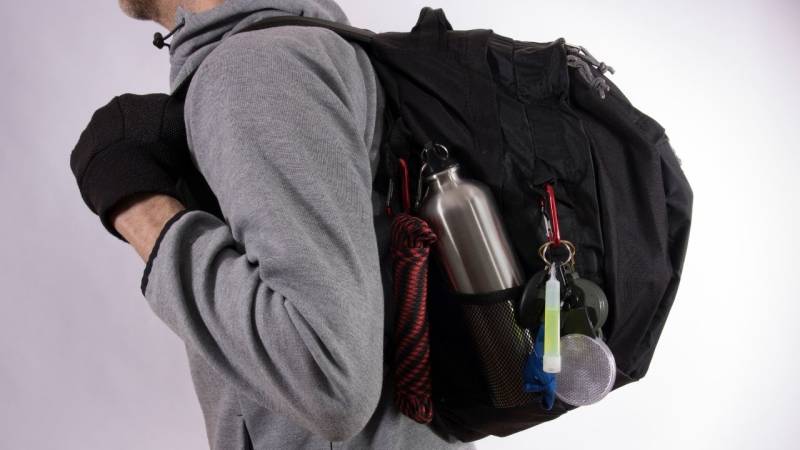
What is a Bug Out Bag? – the most comprehensive guide
👉 The key facts from this guide
- A Bug Out Bag is a backpack equipped with everything necessary for at least 72 hours of survival. The exact equipment depends on your individual needs and the specific emergency.
- The selection of the backpack should be based on robustness and carrying comfort. The color should ideally be inconspicuous and natural.
- The weight of the backpack should not exceed 20% of your body weight. For people who regularly exercise and already have experience carrying equipment, the weight can be up to 30% of their body weight.
- A Bug Out Bag should always contain a first aid kit, water and food, a lighter and kindling, a flashlight, a knife and a multitool, paracord and a tarp for shelter.
- Depending on the level of preparation, the backpack can be additionally equipped with sleeping gear, cooking equipment, additional batteries, a tent, and other survival tools.
- It is important to regularly test and practice using the backpack. Only this way can you ensure that you can effectively handle your Bug Out Bag in an emergency.
Putting together a Bug Out Bag is one of the most important steps you should take to prepare yourself.
These packed and ready-to-use backpacks are worth their weight in gold when you have to leave your home or when you're vulnerable at home.
Even if you never use the emergency backpack, it gives you the security to be able to handle whatever may be necessary.
What you can expect from the guide and what not
But putting together a checklist for your emergency backpack can be daunting - like most people, you'll probably want to take more than you can carry.
And the bad news is:
There is no ONE Bug Out Bag.
Anyone who promises you that and insists on it is naive.
Just putting a list online is not only amateurish, but also irresponsible to your readers.
There are simply too many variables to provide a universal answer that is perfect for all people in all situations.
But here's the good news:
There are still clear, life-changing differences between a good and a bad emergency backpack.
Look, in a survey, 30% of respondents said they already own an emergency backpack.
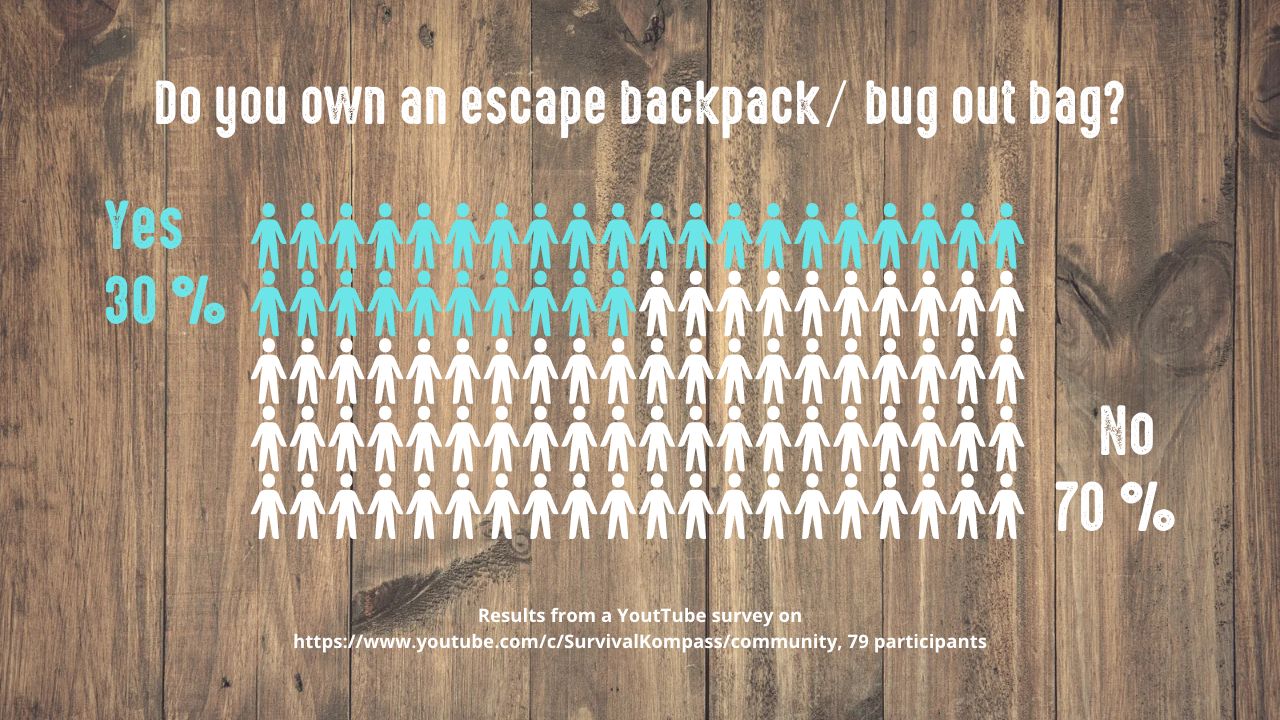
In this ultimate guide, I will explain as much as possible about the Bug Out Bag - how much it should weigh, how big it should be, and which equipment items are useful are just a few of the pieces of information that will be important in the end.
"I believe that an excellent Bug Out Bag starts with a great Bug Out List." - Martin Gebhardt
And the guide is written for people who are seriously considering and starting to prepare themselves.
If you're already familiar with the topic, some equipment items may seem trivial to you - but that doesn't diminish their importance.
Let's now dive deep into the topic and get started.
What does "To Bug Out" mean?
First, I want to clarify what "bug out" actually means. If you enter this word phrase into various translators, it can be translated as "to hastily withdraw".
In general, "Bug Out" means to quickly withdraw from a dangerous situation that threatens your life or the lives of your loved ones.
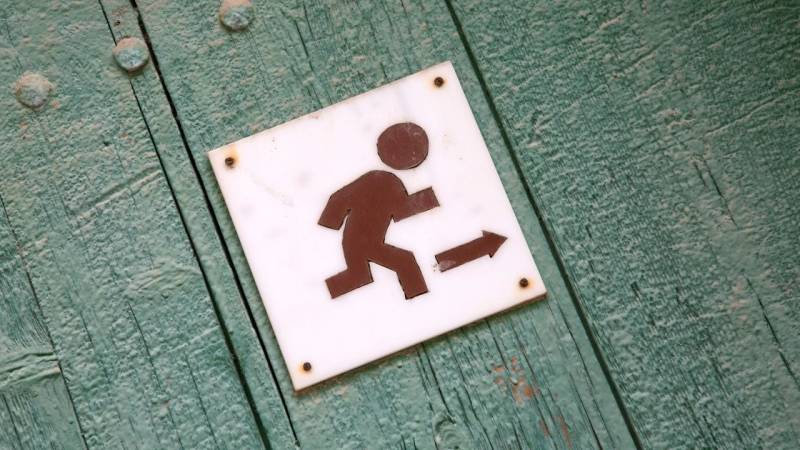
Bug Out is also a general term for an escape situation. There is the escape vehicle (Bug Out Vehicle, BOV), the escape plan (Bug Out Plan, BOP), the escape location (Bug Out Location, BOL), and the emergency backpack (Bug Out Bag, BOB).
And it's the emergency backpack that I want to talk to you about today. Let's now focus in detail on the BOB.
How did the term Bug Out originate?
The term probably originated during World War II. There are cartoons from the 1930s showing bugs fleeing from a foot or boot that is about to crush them.
Ultimately, the term is based on the fast, disordered flight of bugs when they are discovered. This phenomenon is especially noticeable when several bugs are discovered at the same time, for example, under a stone or a can.

What exactly is a Bug Out Bag?
A Bug Out Bag is a collection of equipment that contains everything you need to survive alone for at least 72 hours. The number 72 comes from the fact that as humans, we cannot survive without water for more than 72 hours.
However, a Bug Out Bag does not have to be designed for exactly 72 hours. Some people need it for 12 hours, while others pack a tent for a longer stay in the wilderness in their Bug Out Bag.
As written in the introduction: The contents of your evacuation backpack depend on your situation and needs.
In Germany, the Bug Out Bag is also called "Fluchtrucksack" or "Überlebensrucksack". Its main purpose is, therefore, survival during flight from a disaster or emergency.
Emergencies do not necessarily have to be earthquakes, volcanic eruptions, hurricanes, or blackouts. Just imagine you live in a big city and a bomb from World War II needs to be defused. Then it is very likely that you have to leave your home spontaneously.
In English, other terms are used, such as "72-hour kit," "grab bag," "battle box," "Personal Emergency Relocation Kit (PERK)," "go bag," or "GOOD bag (Get Out Of Dodge)."
How useful is an evacuation backpack?
The main purpose of a Bug Out Bag is to enable quick evacuation in the event of a disaster. It is therefore advisable to gather all necessary goods and equipment, such as in a bag or some storage containers, in one place.
So if you cannot flee with your BOV (Bug Out Vehicle), like a RV, you have to resort to a well-equipped backpack.
Should everyone own a Bug Out Bag?
Bug Out Bags contain the most important utensils for survival on the go. The evacuation backpack is supposed to keep you alive for 72 hours.
Generally, it is advisable to prepare for emergencies and crises with a Bug Out Bag. Especially then, an evacuation backpack can be helpful if you live in flood-prone areas, earthquakes, hurricanes, or other disasters can occur.
Whether you want to be prepared for medical emergencies while traveling or live in a rather stormy weather zone, these backpacks can be vital. However, everyone packs their backpack according to their needs.
A good Bug Out Bag saves time when seconds count in crucial moments. If your evacuation backpack is ready, you can evacuate immediately.
This way, you can concentrate all your time, energy, and attention on getting to safety.
Which evacuation backpack to take?
First things first: Do you even own a backpack? That's great if you do.
I recommend buying a backpack that doesn't break your wallet, is robust, and ideally fits perfectly on your body.
For me, two facts count: The backpack must be well-made. That means it must not have any weaknesses when fully packed. No strap or seam may rip in a way. Even after years of hiking, Bushcrafting, and survival training, my backpack must never show any defects.
Furthermore, a backpack must fit perfectly on my body. I always need a chest and waist strap. Only then can I effectively run, crawl, or bend with the backpack.
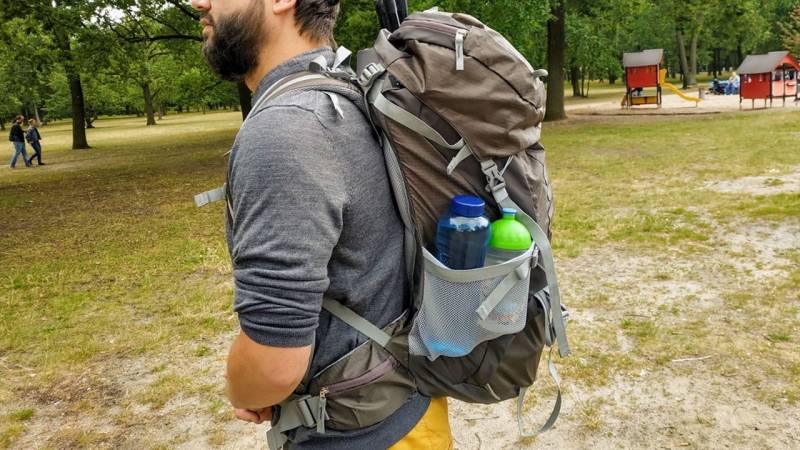
Of course, it is beneficial in the forest if you don't have a red backpack but choose a color that corresponds to a natural color. Olive, brown, gray, and dark green are good suitable colors.
Are pre-made bug out bags useful?
Pre-made bug out bags are not recommended by experts. Almost every company tries to offer a low price by making cuts to the equipment. That means you will probably also buy cheap equipment that you cannot rely on.
Or the purchased bug out bag has the wrong equipment mix from the beginning, and you have to replace/add a lot of material.
Yes, pre-made bug out bags are better than nothing, but overall, they are not customized to your needs.
You also have to keep the climate in mind. What works for you may not work for me. Some people live in a desert, and these people cannot suck sand through a water filter.
But a bug out bag for a power outage looks different from one for an earthquake.
And some bug out bags are full of ready-to-eat meals (MREs), even though you don't need much food in three days. Food plays the least role during that time.
In the best case, you have bought a bug out bag that you will never use, but it gives you a good feeling. In the worst case, you actually rely on it to survive, and you may be seriously injured or even killed.
My tip: Definitely put together your bug out bag.
First, you have to put together a prototype. You go out alone with this bug out bag for three days and practice with it. Plan a hike, build a shelter, light a fire, eat only what you carry, and drink only what you can find and filter.
Thereafter, you will be better able to decide what you need and what you don't.
Answer these questions and prioritize your bug out bag accordingly:
- What will kill me in the next three minutes?
- What will kill me in the next three hours?
- What will kill me in the next three days?
How heavy should your Bug Out Bag be?
Many people usually put together backpacks that are too heavy because they assume that they will be in a vehicle, overestimate their physical fitness, or underestimate how difficult it is to carry 25 kg on their back for hours.
You may have to park your vehicle, hike 19 km through the wilderness, climb high stairs, or wade through floodwaters.
You or someone in your group may get injured. And you will likely be tired, hot/cold, and hungry.
In general, the Bug Out Bag should not exceed 20% of an adult's body weight.
This rule is important because people tend to pack too much.
Here's a great rule of thumb for you:
- If you don't exercise at least three hours a week, you should stay under 20% of your body weight or under 20 kg - whichever is less.
- If you exercise a lot and already comfortably hike with equipment, you can carry up to 30% of your body weight or about 27 kg - whichever is less.
So, if you weigh 80 kg and don't exercise, your backpack should never weigh more than 16 kg.
Studies specifically addressing this question of "optimal packing weight" confirm these rules. A study of hikers on the Appalachian Trail, for example, found that the optimal weight was 13.6 kg, or 20% of body weight.
While another military study found an optimal load of 30% - and that's for soldiers who train every day with heavy equipment.
It is important to test your backpack when fully packed. Go out and hike a few kilometers with it, and you will get a much better feel for the weight.
How big should a Bug Out Bag be?
Depending on the need and emergency, Bug Out Bags with a capacity of at least 25 liters are recommended. The pack volume is increased to a maximum of 50 liters if the Bug Out Bag is designed for several days.
The Checklist - What should be in a Bug Out Bag?
Kindly note that your Bug Out Bag should be tailored to your needs.
And since general lists are not helpful, I have come up with three levels. Level 1 includes the essential equipment. Level 2 builds on Level 1. Level 3 builds on Level 1 and 2.
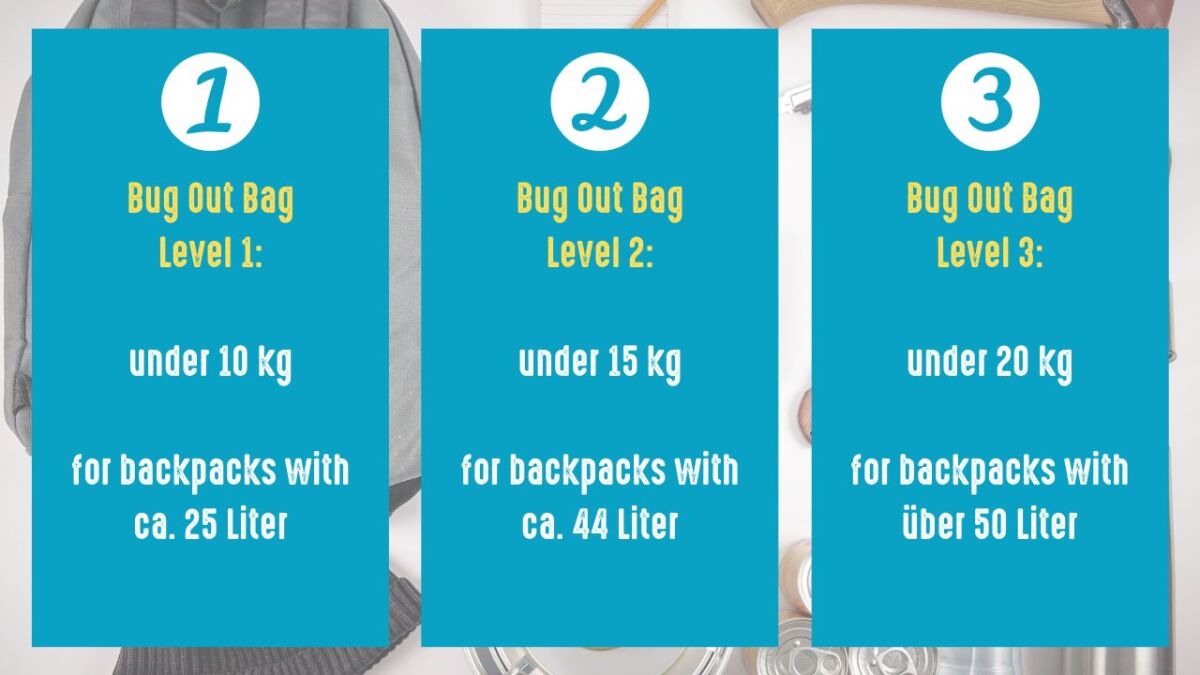
Bug Out Bag Level 1: under 10 kg, for backpacks with about 25 liters
A well-rounded set that covers the essentials you need to survive. Compiled for standard emergencies, such as a natural disaster that disrupts everyday life for a few days.
Bug Out Bag Level 2: under 15 kg, for backpacks with about 44 liters
Now includes a sleeping pad that is strapped to the outside of the backpack. If you want to carry it inside, you'll need a backpack with more than 50 liters.
At this level, you add additional important equipment to the essential equipment, such as a solar charger and sleeping gear.
Bug Out Bag Level 3: under 20 kg, fits in backpacks over 50 L
Now a tent joins the sleeping pad that is strapped to the outside. If you want to carry it in your backpack, you need to plan for about 60 liters of capacity.
The 50-liter Bug Out Bag is ideal for being prepared for various emergencies, including longer-term disasters.
Bug Out Bag Level 1 Checklist

Your 25-liter backpack should not weigh more than 10 kg at Level 1. Here is my recommendation with a link to the product:
- First aid kit, level 1
- 1 liter of water in a stainless-steel water bottle
- Foldable water container
- Water filter
- 30 Water purification tablets
- Food that can be eaten immediately
- 2x Lighter
- Tinder
- Headlamp
- Fixed blade knife
- Multitool
- 30 meters of paracord
- Tarp
- Waterproof notepad and pen
- Documents (on USB and paper)
- Money
- Soap
- Toilet paper
- Cap/hat
- Socks
- Underwear
- Pants (e.g., these outdoor pants)
- Upper base layer
- Jacket
- Shemagh / bandana
- Shoes
- Solar/crank-powered radio
- USB charging cable and wall plug
- Powerbank
- Respirator (and filter if necessary)
- Storage bag
- Smartphone
Bug Out Bag Level 2 Checklist

Your 44-liter backpack should not weigh more than 15 kg at Level 2. In addition to the equipment from Level 1, you will now need the following:
- First aid kit, level 1+2
- Food that requires boiling water
- 20x Storm proof matches
- Portable water cooker
- Pot / cooking vessel
- Spork
- Second flashlight / camping lantern
- Sleeping bag / bivouac sack
- Sleeping pad
- Wet wipes
- Toothbrush and toothpaste
- Lip balm
- Sunglasses
- Binoculars
- Gloves
- Belt
- Map
- Compass
- Solar charger
- Waterproof playing cards / small object for mental health
- Packing straps for securing tents/pads/bags to the outside
Bug Out Bag Stage 3 Checklist

On stage 3, your 50+ liter backpack should not weigh more than 20 kg. In addition to the equipment from stages 1 and 2, you should now add the following:
- First Aid Kit, level 1 + 2 + 3
- Firestarter
- Additional AA/AAA/etc. batteries
- Battery Charger
- Tent
- Hand Sanitizer
- Signal Mirror
- Signal Whistle
- Hand Saw
- Sharpening Stone
- Second Pair of Socks
- Duct Tape
- Survival Handbook
Bug Out Bag Checklist – Items in Detail
Now let's take a closer look at each item and kindly note that each item is not considered as a separate item but as part of a system that pursues your goals.
Many of the items are still versatile, and that is a key criterion for bug out.
You can use a rescue blanket not only as a warming cloak, but also as a shelter to collect water, as a poncho, or to give a signal.
However, I strongly advise against buying a Rambo survival knife that is supposed to do 14 tasks at once. Consider such bonus features only as a replacement.
Water

You surely know that water is vital. However, you have to make some decisions about water because water is unfortunately heavy.
If I am alone on the road for three days, I would have to take at least 9 liters of water with me (for drinking, hygiene, cooking). Even more in summer. So, that's 9 kilos I have to carry. That's almost impossible with a bug out bag.
So ask yourself the following questions:
- Can you carry all of this?
- How can you purify water from nature?
- Is it better to clean, filter, or boil water?
- How do you collect water?
- In what container do you carry water?
First, I recommend that you pack drinking water. It is very risky to rely on finding water in an unknown location.
How much water you take with you is a controversial topic. But take at least 1 liter (1 kilogram) of water with you when you go out. Of course, more water is better, but it increases your weight.
For example, if you live in a hot environment or are very critical that you won't find water, it's better to take 2 liters with you.
Also read: Finding, Collecting, Filtering, and Making Drinking Water
Fill the water in a metal bottle, so you can also boil water in it. This is important if you only have a Level 1 Bug Out Bag.
For making clean water, filtering water is generally better than cleaning it. Mainly because, with filtering, you have immediate access to the water. It's different with cleaning: you wait up to four hours for clean water.
However, cleaning tablets are so light and small that they always make sense to take with you. That's why you'll also find them on the equipment list for the Level 1 Bug Out Bag.
Accordingly, you should also take a small and collapsible water canister with you to cover various scenarios. It can happen, among other things, that you have to filter water slowly. Without a second vessel, you're stuck in the process.
Shelter and Sleep

I find this point the most difficult because good sleeping equipment also weighs something. And good sleep is essential as well as protection from cold, wind, rain, or sun.
Due to different climate zones, terrain, and ground, many people have different preferences. It's difficult to present an all-round solution here.
I advise you to consider three important points:
- What do you sleep on?
- What do you sleep in?
- What do you sleep under?
If you can answer these questions, and you can maintain your core temperature, you have found a suitable solution.
Due to its weight, the Level 1 Bug Out Bag only has the essentials: a tarp.
With several layers of clothing and a fire, you'll survive several nights under the tarp - but sleeping soundly is something else.
Even though it sounds very minimalist at first, you should never do without a tarp. Every outdoor professional has one with them, and especially in a fleeing situation, it's important to protect yourself from the weather.
A tarp not only protects you from wind and rain, but also collects rainwater, hides your emergency supplies, builds a stretcher from it, or seals off an abandoned room so that no wind blows in anymore.
Read this: What is a Tarp? [Sizes, Costs, Setup Variants]
On level 2, it's already more comfortable to sleep and control your body temperature. You now have a sleeping mat and a sleeping bag. I recommend reading my two buying guides for the best sleeping mats and sleeping bags.
This solves a big problem: distance from the cold, heat-sucking ground. Anything that breaks the contact with the ground is helpful.
If you don't have a sleeping mat, look for materials that insulate you from the ground. This can even be a garbage bag or a poncho filled with leaves. Even cardboard and newspaper can make it more comfortable.
Ideally, you should also pack an eye mask and earplugs. I've experienced this myself – not only alone in the woods, but also in a large group.
Imagine you're in a gym because you're supposed to stay there during an emergency (such as the evacuation of the neighborhood due to a bomb threat).
There are many people snoring, farting, crying, chatting, and still using their flashlight because someone is constantly going to the bathroom. And many evacuation rooms are never completely darkened for safety reasons.
Level 3 of your bug out bag includes a one-person tent. This protects you even better from wind, rain, and animals. The great thing about most one-person tents is that two people can fit in them in an emergency.
You're probably wondering why I don't recommend a hammock, right? There are, of course, advantages to elevating yourself off the ground, and you can also sleep on uneven terrain.
But if you're not an experienced hammock camper, I recommend a sturdy bivy sack and a tent.
Also read: Want to Buy a Tent? Then Read This Ultimate Guide to Tents First
Stay away from cheap equipment. Sleeping mats, bivy sacks, and tents usually increase in quality with price. If you spend more, you'll get lighter, better-insulating, and more durable equipment.
Food

Healthy people can survive up to three weeks without food. But it's still good to have something to eat, especially when you need a lot of energy.
Long hikes consume a lot of energy, and you should replenish the calories your body has burned. A small snack also helps against bad moods.
However, food can be heavy and unwieldy, especially when the food contains a lot of water. They also have an expiration date or need to be prepared over a stove.
You need to seek foods that:
- are ready to eat immediately
- only require boiling water
- contain maximum calories in small and lightweight packaging
- are durable and don't spoil quickly
- react well to extreme temperatures
- taste delicious, if possible
Level 1: In the Level 1 Bug Out Bag, there should only be food that you can eat immediately. There is no stove included in the emergency backpack at this level. Here, I recommend muesli and energy bars, nuts, trail mix, jerky, or pemmican (read here what pemmican is and how to make it yourself).
Also read: What food to take into the wilderness? (easy to carry, high energy)
Level 2: In the Level 2 Bug Out Bag, you can now bring food that can be prepared. Here, you have a stove with which you can heat water to prepare food. Trekking or expedition food is perfect for this because of the unbeatable weight-nutrient ratio.
I find MREs (Meal Ready to Eat) tricky because they contain everything your body needs, but they are therefore pricier.
Avoid choosing food that requires more than boiling water. Furthermore, exclude the tea and coffee. If you need caffeine, then check your first aid kit.
Cooking and Eating

Cooking here primarily means boiling water. With the Level 1 Bug Out Bag, you can start a fire and boil your water on it.
At the campfire, you can, of course, fry, roast, or grill something else. For this, you grab a stick and skewer it (fish, meat, vegetables, etc.).
Also read: How do I start a fire? [10 steps to success]
If you have a Level 2 Bug Out Bag, cooking is easier. For example, a small Hobo stove is useful, which can be light and packed flat. The flame is concentrated in one spot, and it is wind-protected.
But I also want to include the gas stove. All you need is a 100-gram gas cartridge and the burner.
However, only bring one type of stove and never both. Each has its advantages and disadvantages, which I list for you here in my guide.
And then there are situations where you don't want to make an open fire because you might want to remain undiscovered.
Or wind and rain make it difficult to ignite. Sometimes time is tight or there is simply no firewood. Then a small stove with fuel, such as an Esbit stove, is well suited.
The clear disadvantage of stoves with fuel is that you have to carry the fuel - such as gas, petrol, Esbit - with you.
If you are skilled in bushcraft and can easily light a fire with natural tinder, then a Hobo stove might be the right choice for you.
Level 2 of your Bug Out Bag now also includes a pot for boiling water. The metal bottle is suitable, but not optimal. You have to transfer your drinking water and the bottle deforms over time.
Get a pot here that fits your gas stove or in which you can store other things precisely. A 1-liter pot is sufficient.
Moreover, consider how you clean your pot. A small brush is quite useful. A salt and pepper shaker spices up dull food.
Avoid using randomly assembled cooking sets. You can use them when you drive to camping in your car.
Fire

Fire warms you, you cook with it, it keeps wild animals away, and it lifts your mood. At the fire, you dry your socks or boil water.
A fire is essential, so it should always be possible to light one.
A simple lighter is the best choice, even if it sounds banal at first. But anyone can use a lighter, and this guide is not written for advanced users, but for normal people.
And two lighters are better than one, which is why you will find them in the Level 1 Bug Out Bag. They are also small and weigh almost nothing. Matches are added at Level 2, and finally, a fire steel at Level 3.
In survival scenarios, there's a good rule: always bring three different fire starters. At level 3, you have a lighter, matches, and a Firesteel. If a lighter doesn't work in too strong wind, use the windproof matches.
And a small Firesteel provides for more than 8000 ignitions, in case you're on the road for more than three days and have already run out of lighter and matches. Take a look at the functionality of the Firesteel for more details.
Also read: The Best Firesteel (Buying Guide)
Always keep your lighters and matches in a waterproof case, and don't forget about the kindling.
Experienced Bushcrafters always have some kindling in their pockets. Whether it's birchbark, Fatwood, or cotton balls dipped in Vaseline (watch the video) - you'll be glad to have these fire accelerators in the rain. Here I have listed many kinds of kindling that you can make yourself or find in the forest.
A Fresnel lens, that is, a magnifying glass, is a fantastic addition to the three ways of making fire in the sun. But first, familiarize yourself with its function.
Clothing

The good thing about clothing is that it can be heavily compressed, and you should therefore have a complete set of clothing in your level 1 bug out bag.
What should you pay attention to? Taking the right kind of clothing!
We can take a look at what trekking hikers pack. Avoid packing denim and cotton and spend some money to get functional textiles.
Your clothing should be windproof, breathable, durable, warming, and lightweight.
Merino wool is a suitable natural fiber. If you use synthetic fiber, use polyester, nylon (polyamide), acrylic, and polyurethane (spandex).
Those who walk a lot and are on the run need 1A socks. Here again, we turn to hikers who mainly wear socks made of merino wool.
The Shemagh in level 1 of your bug out bag is versatile. Of course, it warms up first and protects your neck and head. But it can also be used as an armband or water filter. Make sure to bring it along.
The hat that I recommend in level 1 is only necessary if you're in hot areas or on the road in summer. Here in Europe, it's probably only necessary in summer. This also includes sunglasses, which will be very useful again when there is a lot of snow.
Gloves, like good bushcraft gloves, are included in level 2 and not only protect your hands, but also warm them. If you're in freezing areas, get a thinner glove that fits into the second durable glove.
Also read: The Best Bushcraft Gloves (+ Buying Guide)
You don't need a belt for your level 1 bug out bag equipment. If you already wear one - great. But no later than level 2, you should get a good belt.
There are belts in which you can store your money and on which your survival equipment hangs. But be sure to keep in mind that your weight increases as a result. Some belts are even designed for you to attach MOLLE bags to them.
Also read
The Ultimate Guide: Which Clothing to Wear for Survival Training and Bushcrafting? - The right clothing can make the difference between life and death in survival situations. In this guide, we'll cover what you should wear when you're out in the wilderness.
Light

Small, relatively lightweight, and many modern models can produce a lot of light for a long time with a USB battery or a standard AA/AAA battery.
I'm talking about a flashlight. But not one for your hand, one for your head. Because a headlamp has a huge advantage: you have your hands free.
Take a look, in Stage 1 of your Bug Out Bag, you have a headlamp, but also additional light sources as backups, such as two lighters, a mobile phone, and a solar/crank-powered radio with a lamp.
In Stage 2 of your Bug Out Bag, you now pack in another light source. I don't recommend another headlamp, but rather a lamp that can illuminate a room or tent.
What about candles? Better not because candles will eventually run out and cannot be recharged. In my opinion, they're not worth the weight and space.
Communication

I don't know if you realize this, but your smartphone is a jack-of-all-trades. Just think about all the things it can do:
- Information about your identity
- Search and find information
- Backup flashlight
- Compass
- Map
- Contact option
- Camera
- Entertainment
So, you should be aware that you keep your smartphone on your person at all times, and it doesn't count towards the weight of your Bug Out Bag.
However, it can be useful to have a spare smartphone that has a prepaid card or no SIM card.
Remember that you can call 112 or any number in the world without an active SIM card.
Attention, since 2009 the 112 is no longer reachable in Germany without a SIM card.
You probably already have the question on your mind: What if the mobile network fails?
Then your smartphone is, of course, no longer a tool for communicating with your loved ones. This is where amateur radio comes in.
If you're familiar with radios, you should wear and bring one.
If you're not on the path of the amateur radio operator, most people use a crank-powered and solar-powered radio instead.
Many of these radios have a built-in flashlight and a USB charging port, so you have a backup of solar/crank-powered light and power.
Another choice for communication are small and cheap signal mirrors and signal whistles. They're not as important, so they only appear in Stage 3 of your Bug Out Bag.
Energy

Now we've already discussed flashlights, radios, walkie-talkies, and your smartphone - and yes, these things need to be charged.
Adding a simple wall plug and a USB charging cable completes the setup in Stage 1.
Luckily, many manufacturers have already agreed on USB-C, so multiple adapters are no longer necessary. However, make sure that all your devices are compatible with the charger.
Independent power generation is then done with a solar panel (check out the best list here), which you pack in Stage 2 of your Bug Out Bag. Even though a solar panel adds some weight and takes up space, these devices provide infinite power supply.
A battery charger then comes with you in the evacuation backpack in Stage 3, and you also pack spare batteries.
Of course, you always pack rechargeable batteries. Ideally, all your devices have the same battery types.
Tip: Charge your equipment regularly when you check it. Make sure the charge of your devices doesn't fall below 50%.
Navigation and Orientation

Navigating with a map and compass is a skill that unfortunately many people have forgotten – or rather, never learned.
However, it is incredibly important that you get a feel for your surroundings. You can practice this wonderfully alone by going out without your smartphone GPS and digital map.
Tip: Download basic map information to your smartphone so that you have access to maps if the internet fails.
Survival experts generally believe that a map is more important than a compass. Through various natural signs, you can determine the cardinal directions fantastically. A compass only shows you the NSEW direction, but not where the nearest hospital is.
Also read: Learn how to use a map and compass.
But why isn't a compass and map in the Level 1 Bug Out Bag, even though a map and compass are so light?
All in all, I think that your existing knowledge, your smartphone, GPS apps, your car with navigation, and your sense of orientation are sufficient in numerous instances.
If you decide to pack maps in Level 2 of your Bug Out Bag, then make sure they are waterproof and show the topography. With a compass, you can now determine your location and navigate.
Tools

Now it's time for your knife and multitool. These are two of the most important tools you can carry on your person.
If I had to choose between a knife and a multitool, I would choose a fixed, sturdy, and well-fitting knife (e.g., the Casström Woodsman).
There are very few pieces of equipment that offer more versatility for your money. Both tools should be kept in a sheath that you attach to your belt.
Also read: The best bushcraft knife - the ultimate buying guide
Ropes belong in your toolbox. The possible uses are endless, it is relatively inexpensive, and it will not weigh down your backpack.
For me, paracord is the first choice instead of standard ropes. You can divide paracord into several smaller strands. There are usually 7 inner strands that are so thin that you can use them, for example, for fishing. Some also have a wire inside, others have a tinder cord. Take about 15 meters of paracord with you.
Also read: What is a paracord? - with 39+ examples of use
In Level 3 of your Bug Out Bag, add a folding saw. It will help you make firewood quickly or make other items, such as a wooden hammer or a tripod.
One thing is clear: with a great knife, you will master most requirements in no time, but a handsaw is often quieter, cleaner, and faster.
Also read: The best survival-bushcraft saws
Don't bother with wire saws, which are usually found in amateur survival kits. They simply don't work well enough unless you have a high-quality wire saw and are skilled.
If you are familiar with axes, machetes, or kukris, and they are necessary in your environment, consider whether they might be better to use than the folding saw. But be sure to pay attention to the size because a handsaw is usually much lighter and smaller than an ax or machete.
To ensure that your most important tool – your outdoor knife – stays sharp, pack a sharpening stone in level 3 of your bug out bag. A sharp blade is not only safer, but also allows you to work faster and more precisely.
Also read: This simple and inexpensive trick shows you how to keep your knife sharp
Other tools that can be included in your bug out bag:
- Repair kit: useful for fixing your backpack.
- Fishing equipment: fish are easier to catch than animals in the woods.
- Lock-picking equipment: useful for the city.
If you are traveling in winter and there is a lot of snow, consider whether a shovel makes sense. Snow caves are a fantastic way to stay warm and protect yourself from wind and weather. But be aware of their dangers as well.
First Aid and Hygiene

In level 1 of your bug out bag, you should have a well-packed first aid kit, as described in this guide.
In addition, your bug out bag should also have a respirator mask. These are of crucial importance in emergencies, from fires and pandemics to riots, as they protect your lungs from contamination.
A full-face respirator mask provides the best protection, but it is too large for your bug out bag. Therefore, it is better to use a half-mask respirator that covers your mouth and nose.
With the appropriate industrial safety glasses from level 2 of your bug out bag, you also protect the mucous membranes of your eyes. Smoke, tear gas, or contaminated air are no longer as dangerous. But you will also be better equipped to deal with strong winds or a snowstorm.
Soap may sound banal at first, but if you have ever experienced the havoc that disasters can wreak, you will appreciate having soap. Organizations such as the WHO, CDC, FEMA, and the Red Cross repeatedly emphasize the importance of hygiene in emergencies.
In floods, for example, many fecal and toxic substances spread in the water. Even typhus and tuberculosis are a serious threat in disasters. Soap does not take up much space or weight, so pack it.
Toilet paper is useful so that you can go about your business. Women also pack hygiene products for their period. These measures and soap should be sufficient for level 1 of the bug out bag.
Also read: How to use the bathroom in the woods
From level 2 onwards, you should also carry wet wipes with you. These are not intended for going to the bathroom, but for cleaning your body. Running water will be scarce, so use wet wipes to shower.
In addition, lip balm, a travel toothbrush, and toothpaste should be added from level 2 onwards. Hand sanitizer should be added to your backpack from level 3.
Of course, you can also build a toothbrush from natural materials and use ash as toothpaste. And leaves can also be used as toilet paper. However, many people keep their hands and mouths cleaner with the available items, thereby preventing injuries. If you are an experienced outdoor enthusiast, you can leave these items out.
Remember the following:
- If you wear glasses, take a spare pair in a hard case with you.
- As a woman, avoid menstrual cups, as you are likely to not have clean hands or want to waste soap/water (or you pee on it after emptying it and immediately put it back in).
- If you are diabetic, pack your special medications.
- If you use a hearing aid, also pack hearing aid batteries.
- If you are traveling in bright sunlight, remember sunscreen.
Further tips:
- Dental floss is not a bad addition, as it is incredibly small and light and can serve as a backup fishing line, trap, sewing or general string.
- Iodine tablets do not add much weight, but are crucial in a nuclear scenario.
- A full-face gas mask may be useful if you live near chemical plants.
What you definitely don't need is deodorant. In an emergency, everyone will smell bad. And if you're not near other people, no one will care. Wet wipes and soap provide basic odor reduction.
Read also
Discover my outdoor hygiene tips and tricks to stay healthy and clean in the wild - I'll show you my tips on how to use simple methods to maintain hygiene in the wild, stay healthy and respect nature at the same time.
Documents

A weatherproof notepad and pen are important for leaving messages or taking notes. It's also useful for your children, but more on that later in the entertainment section.
Safeguard your most important documents as follows:
- on a USB stick
- laminate in small size
- on your smartphone
- in the cloud
Furthermore, gather the following copies and pack them in your bug out bag:
- Birth certificate
- Contact/location information
- Contact information for your relatives
- Title and certificates
- Passport
- Vaccination card
- Retirement, pension, and income certificates, income tax notices
- Account numbers, credit card numbers + CVV codes, and phone numbers of providers
- Marriage certificate
- Qualification certificates
- Important medical, home, car, life insurance, and other insurance numbers and phone numbers
- Important medical history, medication (with dosage), and allergies
- Documents proving that you are the lawful parent of your child
- Estate planning documents (will, living will)
At level 3 in your bug out bag, include a survival pocket guide, such as the small booklet by Rüdiger Nehberg "Survival-Lexikon für die Hosentasche".
Read more here: 5 great books about bushcraft
In your children's bug out bags, include a picture of your home, a map with your home marked, and contact information for your family.
Money
Even if a major disaster occurs, cash will still be important, and you should definitely bring some with you.
How much is a matter of debate. It should be as much as you can save and is reasonable. For some people, 300 euros make sense, for others it is 5000 euros.
How helpful cash will depend heavily on the situation. You should definitely store it safely and divided.
Tip: Some people keep gold or silver in the form of small coins. These can also be useful, but jewelry, such as rings or necklaces, is better. You can negotiate better with jewelry and sell it as "my wedding ring". With gold coins, everyone assumes you have more of them.
If you own a cryptocurrency, store it in a paper wallet or secure it on hardware.
Self-defense

Many people believe that there will be riots and violent attacks in an emergency. The fear of this is not unfounded, as people act irrationally and illogically in panic.
If your plan is to use weapons to take what you need from others, then you are a despicable person. But I don't think you are. Otherwise, you wouldn't be learning about a Bug Out Bag.
In Germany, weapon ownership is regulated, and few people have a gun license. However, if you have a gun license, pack a pistol and a full magazine in the second stage of your Bug Out Bag. In stage 3, add two more magazines.
If you don't have a gun license, you're not helpless. Firstly, you have a knife, which is already included in stage 1 of your bug out bag.
And you can legally acquire the following weapons in Germany (sometimes only from the age of 18):
- Crossbows
- Bows
- Air and spring-powered weapons
- Pepper spray
- Electric shock devices
- Blank and signal guns (requires a small firearms license)
I have listed all free weapons in my comprehensive guide to free weapons.
But be careful, you must also store such weapons safely and there are strict rules when it comes to "carrying" weapons. And you can only use weapons in self-defense. Find out more about gun ownership here.
Tip: The best weapon for me is pepper spray. With pepper spray, you don't have to get as close to your attacker as you would with a knife. It's easy to handle, small, and effective. It's also cheap and gives you time to escape.
Crossbows and bows are great items to operate from a distance. However, you have to practice beforehand to be able to handle them. Many people think it's too easy to hit a target accurately over a few hundred meters.
Entertainment

Even in an emergency, it can get boring. Especially if you're alone or have children with you. For your mental health, it's still beneficial to occupy yourself with something enjoyable.
A TV is out of the question, and your hand-cranked radio (find my best list + buying guide here) probably won't play your favorite music.
One or two small things can help you pass the time, cheer up your children, lift your mood, or think about something that has nothing to do with the emergency.
A classic is a deck of waterproof playing cards. It's easy, small, inexpensive, and versatile for you alone or in a group.
What else can help you:
- a book; some people pack meditation books, while others pack the Bible
- paper and pens for drawing
- dice
- games, music, movies, books, and puzzles on your smartphone (remember to bring headphones)
- photos of your loved ones who keep you going
You may also have some vices, such as smoking or alcohol. Then think carefully about whether you need these vices. If you can't sleep without alcohol, then bring some. If you need cigarettes to cope with a shock, then bring some.
Miscellaneous

First, I recommend packing all your equipment into different bags. It is best to use lightweight, waterproof, and colored bags. It's best if all the bags are different colors, so you immediately know that the red bag is your first-aid kit.
Don't pack everything in cloth bags, although there are very durable versions available. Transparent Ziplock bags are excellent, so you can see immediately what equipment the bag contains. You can also collect rainwater in a Ziplock bag or – when it gets tough – keep severed fingers in it.
Whether you use cloth bags, Ziplock bags, or stuff sacks is up to you. But take at least one large waterproof stuff sack that can serve as a flotation device.
By level 1 of your Bug Out Bag, you already have large garbage bags. I recommend using transparent garbage bags because you can use them not only to collect your garbage and use them as a tarp or poncho, but also to collect water through the transpiration method.
Finally, you should pack fasteners for improvising, repairing, and organizing, such as carabiners, reusable cable ties, or packing straps.
At level 2 or 3 of your Bug Out Bag, the sleeping pad, sleeping bag, or tent will be attached to the outside of the backpack. If your backpack doesn't have attachment points, you'll have to use the packing straps.
Well, and what Duct Tape can do, I don't think I need to explain (e.g., treating wounds). The stuff is just genius and belongs in every Bug Out Bag. I'm so enthusiastic about it that I created a separate guide to duct tape.
Tip: If your smartphone dies, pack a watch instead. Ideally, one that can be wound up and has hands. This way, you can determine the direction of the sun and moon.
Tips for a great Bug Out Bag
Weight: Keep your Bug Out Bag light. Many people make the mistake of packing their emergency backpack too heavy.
Priorities: Don't design your Bug Out Bag based on specific schedules such as three days or two weeks – instead, use a priority list in the form of stages.
Goals: Don't pack any extras. It's about survival – not fighting zombie hordes. Make sure you're not thirsty, full, warm, dry, and uninjured. All other equipment supports this condition.
Needs: Put together your Bug Out Bag and don't rely on prefabricated Bug Out Bags. In most cases, they won't meet your needs and will contain inferior equipment.
Quality: Don't buy cheap equipment because cheap equipment is usually heavier. There are, among other things, knives that weigh 235 grams, while others weigh only 120 grams. A Bug Out Bag level 3 equipped with cheap equipment will weigh more than average. Use the money to put together a great Bug Out Bag, level 1 instead.
Spontaneity: Don't assume that your plan will work out when the going gets tough. Always expect unforeseen conditions.
Division: Don't distribute critical equipment to family members because you have to assume that you won't always be able to stay together. It's ridiculous for one person to carry the food and the other to carry the water. Everyone over the age of 10 has their Bug Out Bag.
Children: All group members under 10 years of age should also have a backpack to carry their things. However, don't expect them to carry their equipment – they're still too small for that. But you can pack at least a change of clothes, medication, and documents. Don't pack anything essential there, so you're not stuck if the backpack is lost.
Environment: Always keep an eye on your surroundings, even before the Bug Out. Where do you live? Will there be water? Or even too much, based on a flood? Are you affected by earthquakes or volcanoes? How extreme can temperature differences be for you? Are you in the city or in the countryside? Are there people in the vicinity?
Bags: Pack your equipment in lightweight bags or pouches. Ideally, the bags should be different colors, so you can quickly find the items you need in your Bug Out Bag. If you can handle a few more grams, use waterproof bags.
Rotation: Get all the items and pack your Bug Out Bag once, and don't constantly use your hiking or camping gear. The Bug Out Bag must be ready at all times.
The 7 Most Common Bug Out Bag Mistakes
Mistake No. 1 – Choosing the Wrong Bug Out Bag
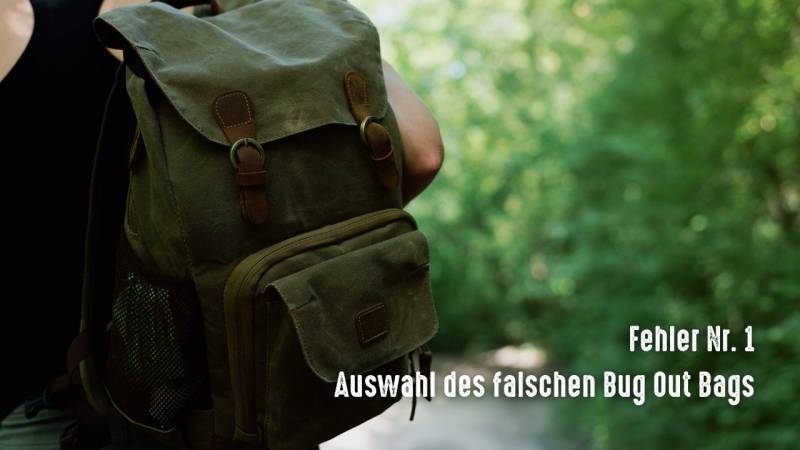
Don't just buy any backpack and leave it in the corner. Get one that you've worn before.
Only then will you recognize whether it is sturdy, offers enough space and adapts well to your body.
You won't hike 5 kilometers with a Bug Out Bag that is completely uncomfortable.
Mistake No. 2 – Your Backpack Doesn't Blend In or Stands Out

When you're on the run, your goal should be not to stand out. You should also look like you're not well-prepared and well supplied.
It is better for you to blend in with the crowds and wear what people normally wear (at least on the surface).
So if you choose a backpack with flashy colors, others will notice you.
The same goes for equipment hanging on the backpack. Some like to pack their axes, cups, compasses or other equipment in the backpack. This will also draw attention to you.
Whether you like blue or red: It is more important that your bag blends in with your surroundings. Some types of bags may look cool in certain places, but unusual in others.
Mistake No. 3 – Taking Unnecessary Gear and Items
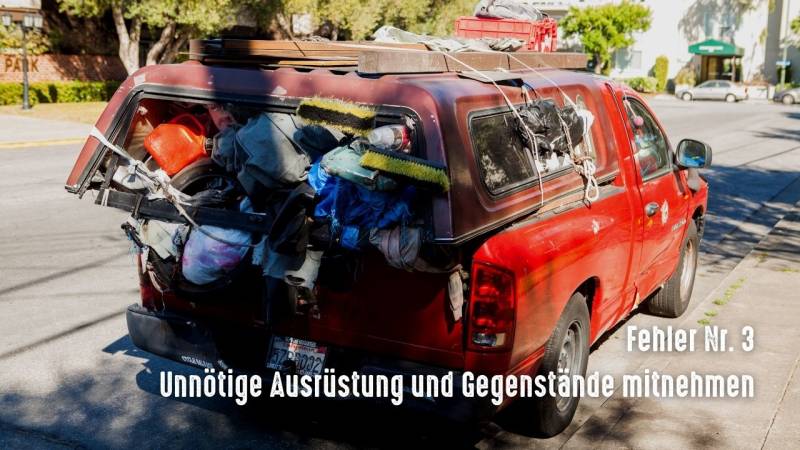
When your life is at stake, you must do everything possible to secure your survival. This means getting rid of unnecessary equipment and making a quick getaway.
A rule of thumb is to pack the essential items when packing your Bug Out Bag.
In English, these are also called the "5Cs", which are: Cutting, Combustion, Cordage, Container, and Cover.
So, first, you need to take care of the following: knife, fire, rope, container, and shelter.
In general, your Bug Out Bag should not weigh more than one third of your total weight. This rule is important because people tend to over pack.
You should always ask yourself if this item is really necessary to help you survive.
Mistake No. 4 – Packing Too Little Food or Water
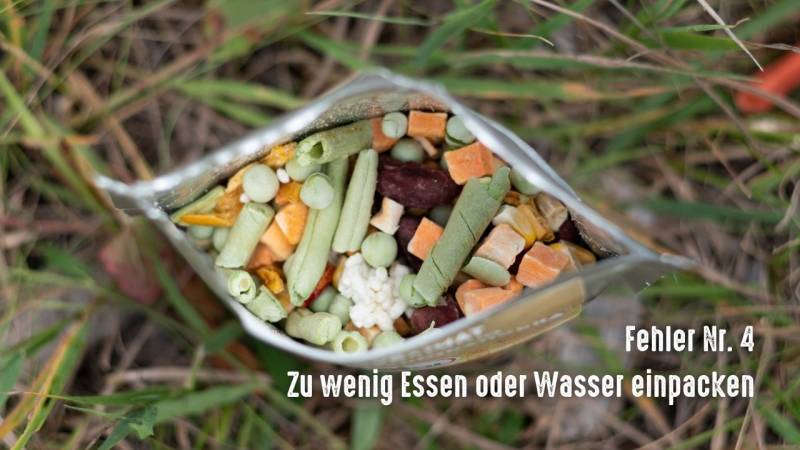
A fatal mistake is packing too little food or water, especially if your environment only has limited food and water resources.
It is common to pack at least one liter of water per day for an adult. Furthermore, be aware that you should drink more in summer than in winter.
Consider using collapsible water containers to give you more storage space. Remember to incorporate a suitable water purification system, so you can filter water.
A recommended ration of 2000 kcal is a minimum for a medium-sized adult. The food you choose should give you enough energy to keep your body going.
I recommend taking energy bars or backpack meals as they contain more calories.
Also read: Survival Basics: What food to take into the wilderness?
Error No. 5 – Forgetting Important Documents
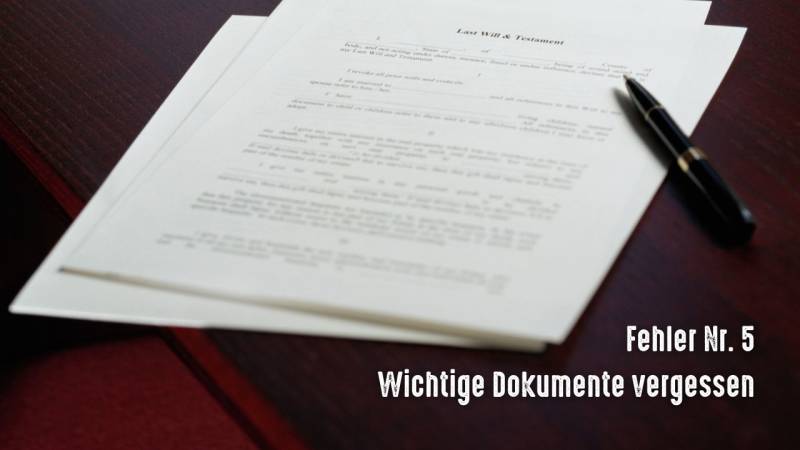
When you leave your home, you should take certain documents with you.
Identity documents are crucial for government agencies to verify your nationality.
Even if you lose your wallet on the way, identification documents will help you to be easily identified.
Error No. 6 – Lack of Practical Training

As the old saying goes, practice makes perfect.
Imagine your bug-out bag is filled with all kinds of tools and materials, but you don't know how to use them. That would be fatal in a SHTF scenario.
The items you bring in your bug-out bag must be SIGNIFICANT for your survival. And an item can only prove significant if you know how to use it correctly.
I recommend that you practice regularly so that you enjoy it. For example, plan a monthly camping trip to the woods with your family.
If your kids enjoy it, they will learn the skills much faster. You could even build a children's bushcraft camp with them.
Remember, the goal of these exercises is to become familiar with the equipment you have in your bug-out bag.
If you have the skills to use your equipment effectively, your chances of survival increase dramatically.
Error No. 7 – Not Packing a Repair Kit
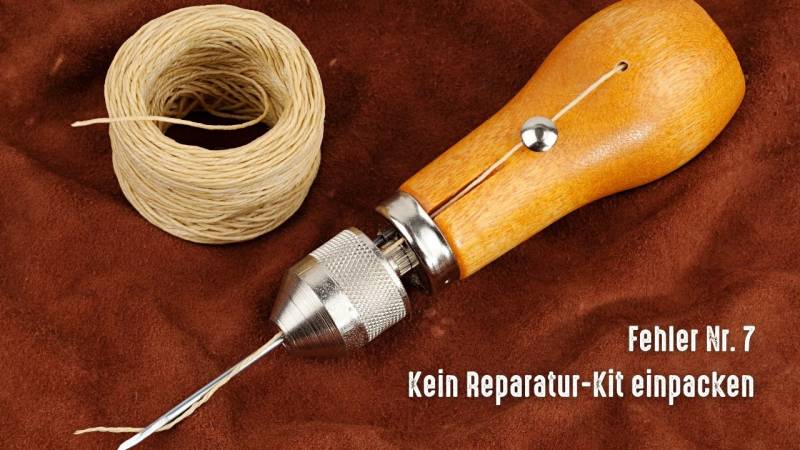
Often, people find out that their bug-out bag is not as durable as expected. Most people assume that they will only need to carry their backpack for 72 hours before returning to their cozy home.
To avoid a defective bug-out bag, I suggest that you bring a sewing kit. This allows you to repair your bug-out bag if necessary. Two or three needles and some threads work great. I recommend using tear-resistant thread, which is used in leather processing.
Furthermore, you should protect your backpack conscientiously. Since your bug-out bag contains all the essential utensils, it only makes sense to take special care of it.
Summary
Putting together a bug-out bag may have been overwhelming at first, but you should now have a comprehensive overview.
Think about where your journey is going when you have to leave your home. Customize your bug-out bag to the circumstances and your needs.
Every bug-out bag is as individual as the person who carries it.
And one more thing: acquire the skills and abilities. A compass is useless without knowledge. A knife is pointless if you don't know what you can do with it.
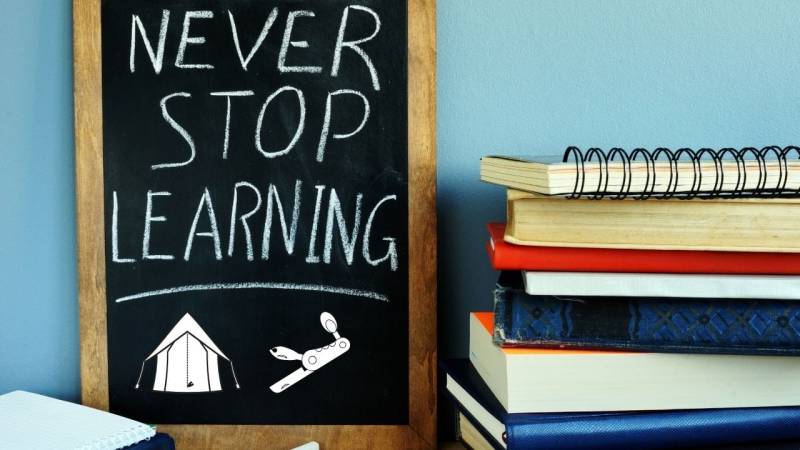
You can read extensively on my website, especially under the categories of Survival and Bushcraft.
In any case, I wish you success in packing your bug-out bag and then write to me in the comments to let me know what you packed.

Sources for the guide
https://www.bbk.bund.de/DE/Warnung-Vorsorge/Vorsorge/Notgepaeck/notgepaeck_node.html
https://taskandpurpose.com/health-fitness/combat-load-weight-research/
https://www.ready.gov/kit
https://www.getprepared.gc.ca/cnt/kts/bsc-kt-en.aspx
https://www.bbk.bund.de/DE/Warnung-Vorsorge/Vorsorge/Hygiene/hygiene_node.html
https://www.krankenhaushygiene.de/pdfdata/2021-07-16-Hygiene-bei-Flutkatastrophen%2810%29.pdf
https://www.asb.de/unsere-angebote/erste-hilfe/erste-hilfe-mit-selbstschutzinhalten/krisenvorsorge-die-richtige-ausruestung-fuer-die-katastrophe
https://theprepared.com/bug-out-bags/guides/bug-out-bag-list/

Author of the guide
Martin Gebhardt
Hey, I'm Martin. On my blog, you will learn the basics and numerous details about living in the wild. I think survival, bushcraft and the good life in nature are the keys to happiness. Find me here on Instagram or on YouTube. You can find more about my mission on the About Me page.
Was this guide helpful?
58 people found this guide helpful.
4.93 out of 5 points (59 Ratings)
Comments (0)
This post may contain affiliate links. So if you click on the links and make a purchase, I will receive a small commission at no additional cost to you. Click here, to learn more about it.


